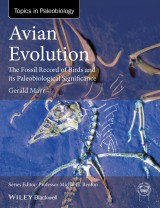Details
Avian Evolution
The Fossil Record of Birds and its Paleobiological SignificanceTOPA Topics in Paleobiology 1. Aufl.
|
77,99 € |
|
| Verlag: | Wiley-Blackwell |
| Format: | EPUB |
| Veröffentl.: | 08.09.2016 |
| ISBN/EAN: | 9781119020738 |
| Sprache: | englisch |
| Anzahl Seiten: | 320 |
DRM-geschütztes eBook, Sie benötigen z.B. Adobe Digital Editions und eine Adobe ID zum Lesen.
Beschreibungen
<P>Knowledge of the evolutionary history of birds has much improved in recent decades. Fossils from critical time periods are being described at unprecedented rates and modern phylogenetic analyses have provided a framework for the interrelationships of the extant groups. This book gives an overview of the avian fossil record and its paleobiological significance, and it is the only up-to-date textbook that covers both Mesozoic and more modern-type Cenozoic birds in some detail. The reader is introduced to key features of basal avians and the morphological transformations that have occurred in the evolution towards modern birds. An account of the Cenozoic fossil record sheds light on the biogeographic history of the extant avian groups and discusses fossils in the context of current phylogenetic hypotheses. This review of the evolutionary history of birds not only addresses students and established researchers, but it may also be a useful source of information for anyone else with an interest in the evolution of birds and a moderate background in biology and geology.</p>
<p>Foreword ix</p> <p>Preface xi</p> <p>Acknowledgments xiii</p> <p><b>Chapter 1 An Introduction to Birds, the Geological Settings of Their Evolution, and the Avian Skeleton 1</b></p> <p>Birds Are Evolutionarily Nested within Theropod Dinosaurs 2</p> <p>The Geological Settings of Avian Evolution in a Nutshell 4</p> <p>Characteristics of the Avian Skeleton 6</p> <p><b>Chapter 2 The Origin of Birds 18</b></p> <p>Archaeopteryx: The German “Urvogel” and Its Bearing on Avian Evolution 19</p> <p>The Closest Maniraptoran Relatives of Birds 22</p> <p>Feather Evolution 32</p> <p>The Origin of Avian Flight 37</p> <p><b>Chapter 3 The Mesozoic Flight Way towards Modern Birds 43</b></p> <p>Jeholornithids: Early Cretaceous Long-Tailed Birds 44</p> <p>Confuciusornis, Sapeornis, and Kin: Basal Birds with a Pygostyle 45</p> <p>Ornithothoraces and the Origin of Sustained Flapping Flight Capabilities 50</p> <p>The Ornithuromorpha: Refinement of Modern Characteristics 55</p> <p>Ornithurae and the Origin of Modern Birds 59</p> <p><b>Chapter 4 Mesozoic Birds: Interrelationships and Character Evolution 64</b></p> <p>The Interrelationships of Mesozoic Birds: Controversial Phylogenetic Placements and Well-Supported Clades 65</p> <p>Character Evolution in Mesozoic Birds 68</p> <p>Ontogenetic Development of Mesozoic Birds 81</p> <p><b>Chapter 5 The Interrelationships and Origin of Crown Group Birds (Neornithes) 84</b></p> <p>Phylogenetic Interrelationships of Neornithine Birds 85</p> <p>The Mesozoic Fossil Record of Neornithine-Like and Neornithine Birds 88</p> <p><b>Chapter 6 Palaeognathous Birds (Ostriches, Tinamous, and Allies) 94</b></p> <p>The Interrelationships of Extant Palaeognathae 95</p> <p>Early Cenozoic Palaeognathous Birds of the Northern Hemisphere 95</p> <p>Long-Winged Ostriches, Rheas, and Tinamous 97</p> <p>Short-Winged Palaeognathous Birds 101</p> <p>Biogeography: A Textbook Example of Gondwanan Vicariance Has Been Dismantled 105</p> <p><b>Chapter 7 Galloanseres: “Fowl” and Kin 107</b></p> <p>Galliformes: From Herbivorous Forest Dwellers to Seed Eaters of Open Landscapes 108</p> <p>The Waterfowl 113</p> <p>Gastornithids: Giant Herbivorous Birds in the Early Paleogene of the Northern Hemisphere 118</p> <p>Dromornithids (Mihirungs or Thunderbirds): Gastornis-Like Birds from Australia 120</p> <p>Pelagornithids: Bony-Toothed Birds 121</p> <p><b>Chapter 8 The “Difficult-to-Place Groups”: Biogeographic Surprises and Aerial Specialists 125</b><br /><br />The Columbiform Birds: Doves, Sandgrouse, … and Mesites? 126</p> <p>The Hoatzin: A South American Relict Species 127</p> <p>Turacos and Cuckoos 129</p> <p>Bustards 131</p> <p>The “Wonderful” Mirandornithes, or How Different Can Sister Taxa Be? 132</p> <p>Strisores: The Early Diversification of Nocturnal Avian Insectivores 136</p> <p><b>Chapter 9 Shorebirds, Cranes, and Relatives 147</b></p> <p>Charadriiformes: One of the Most Diverse Groups of Extant Birds 148</p> <p>From Rail to Crane 156</p> <p><b>Chapter 10 Aequornithes: Aquatic and Semi-Aquatic Carnivores 161</b></p> <p>Loons: Foot-Propelled Divers of the Northern Hemisphere 162</p> <p>Pelagic Tubenoses and Albatrosses 164</p> <p>Penguins: More Than 60 Million Years of Flightlessness 168</p> <p>The Polyphyletic “Pelecaniformes” and “Ciconiiformes” 174</p> <p>Late Cenozoic Turnovers in Marine Avifaunas 187</p> <p><b>Chapter 11 Cariamiforms and Diurnal Birds of Prey 189</b></p> <p>Seriemas and Allies: Two Species Now, Many More in the Past 190<br /><br />Diurnal Birds of Prey: Multiple Cases of Convergence among Raptorial Birds 197</p> <p><b>Chapter 12 The Cenozoic Radiation of Small Arboreal Birds 204</b></p> <p>The Courol and Mousebirds: Two African Relict Groups 205</p> <p>The Long Evolutionary History of Owls 210</p> <p>Parrots and Passerines: An Unexpected Sister Group Relationship and Its Potential Evolutionary Implications 212</p> <p>Trogons, Rollers, and Woodpeckers: Cavity-Nesters with Diverse Foot Morphologies 223</p> <p><b>Chapter 13 Insular Avifaunas Now and Then, on Various Scales 233</b></p> <p>Islands and Isolated Continents as Refugia 234</p> <p>The Evolution of Flightlessness in Predator-Free Environments 235</p> <p>Insular Gigantism and Islands as Cradles of Unusual Morphologies 241</p> <p>Glossary 245</p> <p>References 248</p> <p>Index 289</p>
"Of all the works on the evolution of birds, it is the most modern, complete summary, with just enough fossil figures (no reconstructions), including 16 central color pencils, morphological descriptions and of genealogical trees. A mine of reflections that illuminate our current settlements" <b>Ornithos, 24:5 (2017)</b>
<p>Gerald Mayr is a German paleontologist who is Curator of Ornithology at the Senckenberg Research Institute in Frankfurt am Main, Hesse. He has published extensively on fossil birds, especially the Paleogene avifauna of Europe. He is an expert on the Eocene fauna of the Messel pit.</p>


















